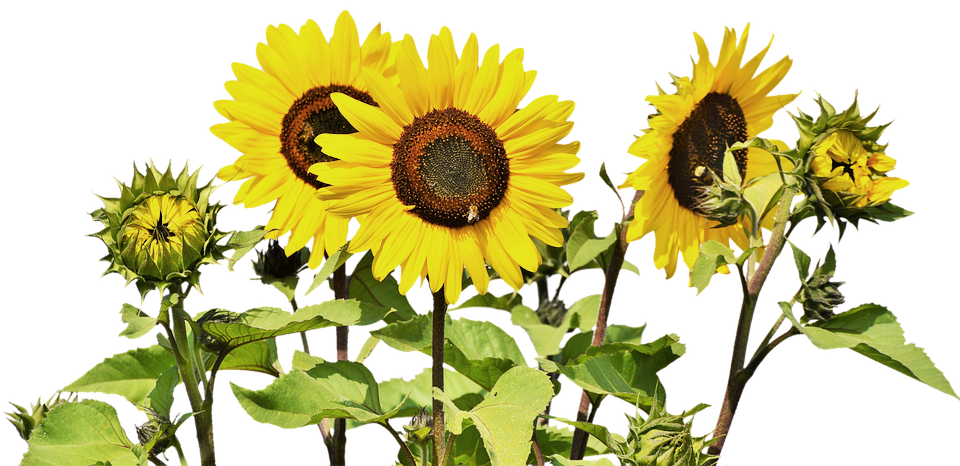
Caring for Hanging Baskets
By Chris Edmunds
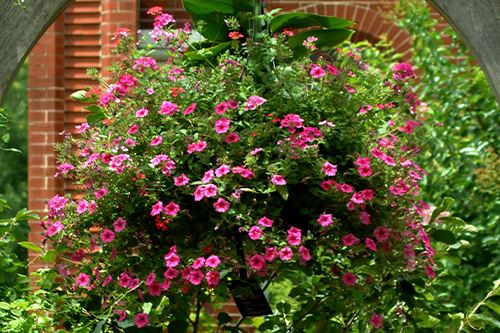
A hanging basket overflowing with lush foliage and vibrant flowers is the perfect complement to your deck, patio, or sunroom. Hanging baskets draw the eye upward, making the space seem larger, lusher, and more put-together. Like all container gardens, a hanging basket is a closed environment that requires some special care to last all season long. A little TLC goes a long way toward keeping your baskets looking their best!
Proper Watering of Hanging Baskets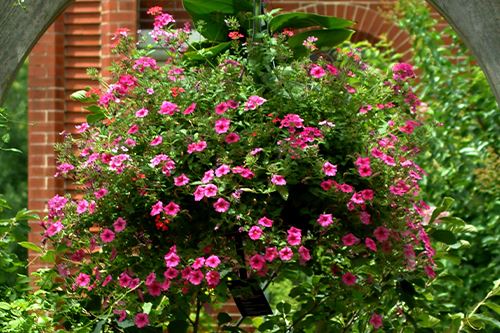
Getting the moisture balance in your hanging baskets just right may be the trickiest part of caring for them. Hanging baskets generally require evenly moist soil for best results, but overwatering can increase the risk of drowning or rotting the roots. Here are some tips for keeping your baskets properly watered:
Plant roots have a low tolerance for sitting in standing water, so all hanging baskets should allow water to drain out the bottom. Your hanging basket should have at least one adequately sized drain hole to let excess water flow through, rather than pooling at the bottom of the basket. Drainage also prevents salt build-up, which kills roots.
Since most hanging baskets are quite small and should be evenly watered, it’s best to place plants with similar moisture requirements together. A general rule of thumb to help you make your choices is to pair vigorous growing plants with similarly vigorous growers, and slow-growers with fellow slow-growers. This will help keep the thugs from overpowering the small guys.
Notice how long it takes your plants to dry out. The material of the pot (breathable, such as moss coco-liner, and fiber vs non-breathable plastic or resin), location of the pot (sun or shade), and weather (windy, hot, rainy, etc.) can all affect how often you need to water. Your basket needs water if the soil feels dry up to the first knuckle of your finger. In spring, you may be able to wait several days before the soil feels dry. In the summer heat, you'll need to water more often, probably every day or possibly even twice a day.
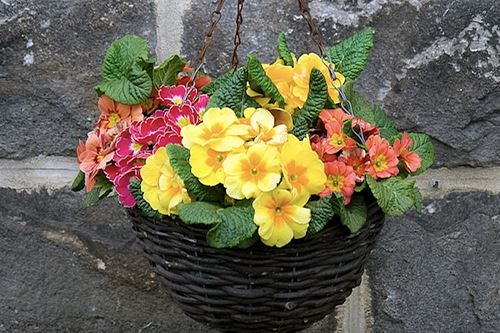 Use a high-quality potting soil to regulate the amount of water your hanging basket will need. KVG Premium Potting Soil™ uses long fibers to help your hanging baskets retain moisture longer. It also contains KVG “The Good Stuff” controlled-release fertilizer to boost plant growth.
Use a high-quality potting soil to regulate the amount of water your hanging basket will need. KVG Premium Potting Soil™ uses long fibers to help your hanging baskets retain moisture longer. It also contains KVG “The Good Stuff” controlled-release fertilizer to boost plant growth.
Some hanging baskets are very prone to drying out quickly, often because of their smaller capacity or exposure to the sun and wind. Water thoroughly every time your plants need to be watered. Fill the basket to the brim. Wait a minute or two for that water to seep through, then fill the basket a second time to be sure that all the soil gets thoroughly saturated. This makes sure the whole root system of your plants gets a chance to take a drink, while the excess will drain out the bottom.
Sometimes, if the soil is quite dry, the first watering just breaks the surface tension and oftentimes, most of it just drains down the sides without soaking the soil. It's the second watering that actually makes all the soil wet.
Applying Fertilizer to Hanging Baskets
We couldn’t survive on water alone, and neither can your plants! The soil in the hanging basket needs to have plenty of nutrients to help your plants grow healthy foliage and lots of big, colorful blooms. As a general rule of thumb, the more vigorous your plants are and the more frequent you are watering, the more fertilizer your plants need because frequent watering leaches the nutrients and vigorous growers generally need more fuel.
Slow-release fertilizer pellets are an easy and effective way to keep a steady supply of plant nutrition available for your plants. Start using fertilizer pellets mixed into your soil before planting in the spring to help annuals charge up for a vibrant blooming season. KVG “The Good Stuff™” fertilizer is a controlled-release formula that’s perfectly balanced for big, bountiful flowers.
In the summertime, switch to a water-soluble fertilizer formula and apply weekly or bi-weekly, per your plant’s needs. This will help to boost the nutrients in the soil and keep them blooming as long as possible. Do not fertilize if temperatures are above 95 degrees, as it can burn the roots. It's always best to do your watering in the evening or morning, and this is especially good advice when applying a water-soluble fertilizer.
Hanging Basket Maintenance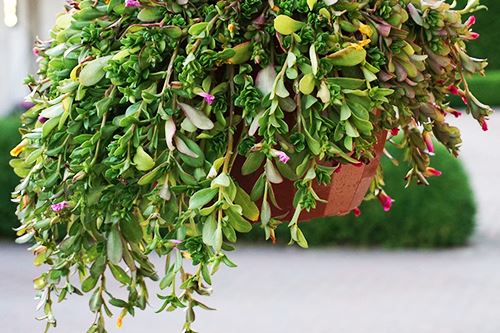
With plenty of water and nutrients, your plants will quickly start to fill your hanging basket—and may look like they’re growing out of control! A little bit of simple pruning will keep your basket looking tidy.
Use a pair of scissors to prune back any limbs that look overgrown and out of proportion with the other plants in the basket. This will promote branching and keep the hanging basket from looking lopsided. It will also give the other plants room to grow and show off better.
Don't be afraid to cut the plant back as much as 1/3 to 1/2 way. And if a particular plant is not looking good, don't be afraid to pull it out. The other plants will fill in. Simply hold down the soil around the base of the plant you want to pull with one hand, while pulling the plant out with your other hand. This will force the roots to come up between the fingers you are using to hold the soil down so as to cause the least disturbance to the other plants.
Throughout the season, deadhead spent blooms by pinching them off below the seed pod located at the center of the bloom. This will make sure the plant doesn’t spend any energy trying to keep old flowers alive and free up energy to grow new ones. Many newer varieties no longer require deadheading to promote new flowers, but if the dead blooms detract from the overall beauty of the basket, you might want to deadhead to keep it looking fresh.
Perfect Plants for Hanging Baskets
Certain flowers are simply perfect for hanging baskets. Plants that naturally mound and spill gently over the sides of the container give a container a symmetrical, elegant look, and are perfectly complemented by the "weavers" for a truly stunning effect. Try these classic flowering plants in your hanging baskets:
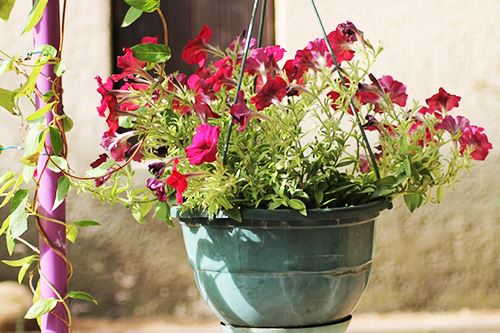 Begonia: These can be found in a large range of bloom and foliage colors. "Waterfall Encanto Orange" and "Dragon Wing Red" begonias are especially lovely varieties for hanging baskets.
Begonia: These can be found in a large range of bloom and foliage colors. "Waterfall Encanto Orange" and "Dragon Wing Red" begonias are especially lovely varieties for hanging baskets.
Calibrachoa: Treat your baskets to an abundance of flowers with these ultra-colorful intense bloomers—they are nicknamed "Million Bells" for a good reason! Be careful not to overwater, as these can succumb to root rot fairly easily if kept too wet.
Impatiens: If you get impatient with deadheading, impatiens may be for you! These self-cleaning annuals drop their own spent blooms and replace them with more cheerful ones. They are perfect for shaded locations that many hanging baskets are hung in. Mix with ivy (hedera), 'Sprengeri' asparagus fern, begonias, setcresia 'PurpleHeart', euphorbia 'White Manaus', torenia 'Summer Wave Large Violet', and other shade-loving plants. Houseplants, such as spider plants, wandering Jew, Swedish ivy, and other "trailers" can also create a lush effect combined with Impatiens!
Geraniums: Geraniums are a treat for the senses, with gorgeous flower balls in a multitude of colors. The 'Caliope' and 'Caliente' series are a fairly new interspecific breed perfectly suited for hanging baskets. They are a cross between the standard "zonal" geraniums and trailing "ivy" geraniums. The result is greater heat tolerance, more flower power, and a mounded, semi-trailing habit. Traditional "zonal" geraniums can be used in the center for a "thriller" ingredient, but the habit is upright, so you might want to add "spillers" and "fillers" to complete the look.
Petunias: Few gardeners can resist these ever-popular container flowers, which grow abundant trumpet-shaped blooms in a wide range of colors and patterns. Smaller blooms can be the supporting cast, while the large, vibrant flowers of Petunias take center stage. Some have the perfect mounded habit, like 'Sweetunia Pink Lemonade' and 'Potunia Purple Halo', while others have huge, trailing habits, like the 'Supertunia' series from Proven Winners or the 'Cascadia' series.
Verbenas: These are perfect for giving a contrast to the trumpet-shaped flowers of petunias and calibrachoa. They also "weave" well through the basket, filling in the gaps between other plants, much like baby's breath in a bouquet. There are solid colors, ones with bright, white "eyes", and other gorgeous patterns and colors to choose from to either compliment or contrast with your other ingredients.
There are plenty of other beautiful plants you can experiment with for dazzling hanging baskets. Try a mixture of flowers and foliage plants to create your own basket. May yours be a masterpiece!

